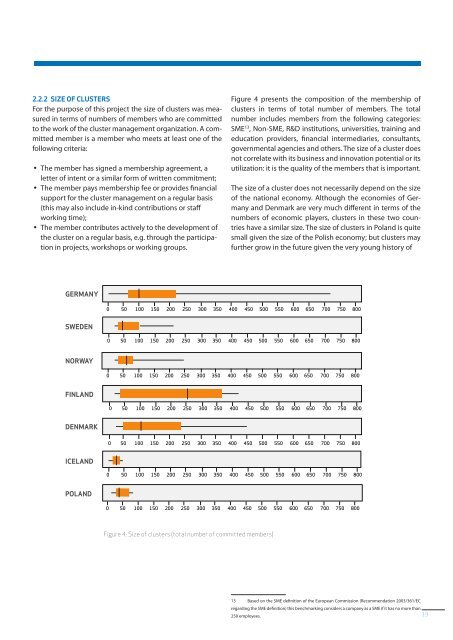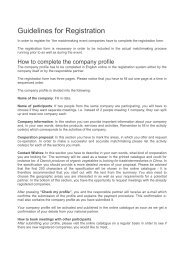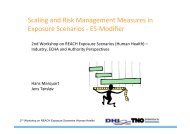Clusters are individuals - VDI/VDE-IT
Clusters are individuals - VDI/VDE-IT
Clusters are individuals - VDI/VDE-IT
You also want an ePaper? Increase the reach of your titles
YUMPU automatically turns print PDFs into web optimized ePapers that Google loves.
2.2.2 SIZE OF CLUSTERS<br />
For the purpose of this project the size of clusters was measured<br />
in terms of numbers of members who <strong>are</strong> committed<br />
to the work of the cluster management organization. A committed<br />
member is a member who meets at least one of the<br />
following criteria:<br />
• The member has signed a membership agreement, a<br />
letter of intent or a similar form of written commitment;<br />
• The member pays membership fee or provides financial<br />
support for the cluster management on a regular basis<br />
(this may also include in-kind contributions or staff<br />
working time);<br />
• The member contributes actively to the development of<br />
the cluster on a regular basis, e.g. through the participation<br />
in projects, workshops or working groups.<br />
Figure 4 presents the composition of the membership of<br />
clusters in terms of total number of members. The total<br />
number includes members from the following categories:<br />
SME 13 , Non-SME, R&D institutions, universities, training and<br />
education providers, financial intermediaries, consultants,<br />
governmental agencies and others. The size of a cluster does<br />
not correlate with its business and innovation potential or its<br />
utilization: it is the quality of the members that is important.<br />
The size of a cluster does not necessarily depend on the size<br />
of the national economy. Although the economies of Germany<br />
and Denmark <strong>are</strong> very much different in terms of the<br />
numbers of economic players, clusters in these two countries<br />
have a similar size. The size of clusters in Poland is quite<br />
small given the size of the Polish economy; but clusters may<br />
further grow in the future given the very young history of<br />
GERMANY<br />
0 50 100 150 200 250 300 350 400 450 500 550 600 650 700 750 800<br />
SWEDEN<br />
0 50 100 150 200 250 300 350 400 450 500 550 600 650 700 750 800<br />
NORWAY<br />
0 50 100 150 200 250 300 350 400 450 500 550 600 650 700 750 800<br />
FINLAND<br />
0 50 100 150 200 250 300 350 400 450 500 550 600 650 700 750 800<br />
DENMARK<br />
0 50 100 150 200 250 300 350 400 450 500 550 600 650 700 750 800<br />
ICELAND<br />
0 50 100 150 200 250 300 350 400 450 500 550 600 650 700 750 800<br />
POLAND<br />
0 50 100 150 200 250 300 350 400 450 500 550 600 650 700 750 800<br />
Figure 4: Size of clusters (total number of committed members)<br />
13 Based on the SME definition of the European Commission (Recommendation 2003/361/EC<br />
regarding the SME definition) this benchmarking considers a company as a SME if it has no more than<br />
250 employees.<br />
19

















